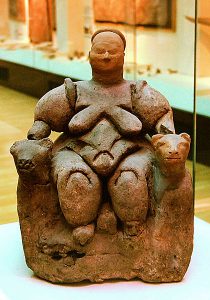 James Mellaart
James Mellaart
British archaeologist, James Mellaart, was born in London in 1925. His family moved to Holland where his father worked as an expert in Dutch old master paintings and drawings. At the outbreak of World War II, Mellaart secured a position at the museum in Leiden, where he worked until the war ended. Then he enrolled in University College in London where he studied egyptology. His studies led him to join the British Institute of Archaeology at Ankara, Turkey.
In the early 1950s, he began an archaeological survey of Anatolia. His first dig at Hacular produced a cache of painted pottery and female figurines that led to speculation about an early culture that worshipped a mother-goddess. Then, in November 1961, he began excavating a 20-meter high mound on the plains of Konya known locally as Çatalhöyük. There, he unearthed thirteen levels of occupation dating back over nine thousand years that contained the remains of a population center housing up to 10,000 people at its zenith.
“Inside the mudbrick houses and shrines – which had no front doors but were entered through the roof – Mellaart and his team found bull’s heads, skeletons, mirrors of black obsidian, plaster reliefs, and wall paintings so extraordinary that their interpretation remains controversial to this day. Çatalhöyük was not as old as Jericho, but it was three times the size and a much more advanced example of the Agricultural Revolution, a transformation of human society greater even than the Industrial Revolution of modern times.” – Cornucopia Magazine
Mellaart developed a theory that, like the people of Hacular, residents of Çatalhöyük engaged in the worship of a mother goddess, based on the discovery of a number of female figurines that he had unearthed. However, over 2,000 figurines have since been unearthed in Çatalhöyük and less than two percent depict human females. This has led modern scholars to speculate that Mellaart’s “mother goddess theory” is probably incorrect.
Mellaart excavated the site for four years but, when heretofore unknown Turkish antiquities, thought to have originated from some of his earlier digs, surfaced in the art world, Turkish authorities canceled his excavation permit and he was thereafter barred from his most famous discovery. Mellaart returned to London where he lectured at the Institute of Archaeology until his retirement. He now lives near Finsbury Park in north London.
Some of his published works include The Archaeology of Ancient Turkey, Çatalhöyük a Neolithic Town in Anatolia, Earliest Civilizations of the Near East, The Earliest Settlements in Western Asia: From the Ninth to the End of the Fifth Millennium B.C., Excavations at Hacilar, and The Neolithic of the Near East.





